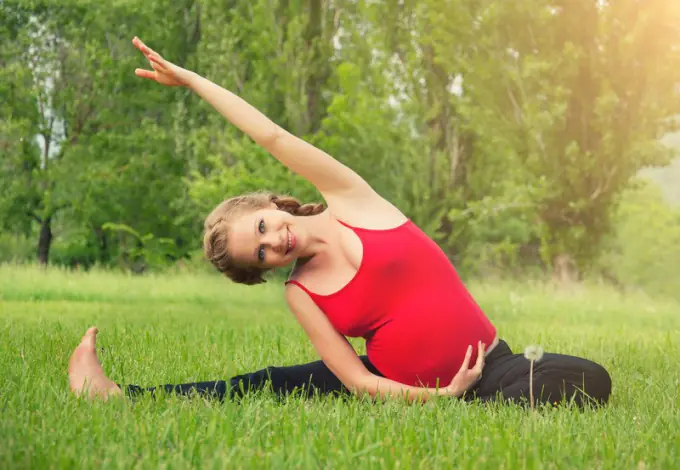
Benefits of Leg Stretching for Pregnancy
Stretching the legs helps relieve muscle tension, expand the range of joint mobility, improve coordination and circulation, improve metabolism, increase endurance, and mentally relax. All this is the prevention of such common ailments in pregnant women as varicose veins and edema. Additionally, for women in the position, leg stretching provides additional benefits. They are sprains of the muscles, ligaments and bones of the pelvic floor. This, in turn, is a good prevention of protracted labor, ruptures and incisions of the perineum, and fetal hypoxia.
The pelvic floor consists of the pelvic bones and six muscles. During childbirth, all the muscles and bones of the pelvic floor stretch and form the birth canal.
Features of leg stretching during pregnancy
During pregnancy, you need to comply with a number of conditions when performing stretching exercises. You should always warm up before these exercises. Pregnant women can only perform static exercises and avoid straining muscles that hurt. Perform the exercises slowly, without tension. You should not get carried away with the “fold” exercise and do exercises with the starting position on your back.
You cannot perform leg stretching exercises if: there is a threat of miscarriage or premature birth; a weak cervix was diagnosed; there was bloody discharge; abnormal placenta previa; there is a nagging pain in the lower abdomen and lower back.
Leg stretching exercises for pregnant women
These exercises can be done every day.
Static exercises are exercises for holding a pose without hesitation or jerking.
Butterfly. Sit on the mat, legs in front of you, bring your feet together, pull your knees down (you can swing them). You can help lower your knees with your elbows (as in prayer) or with your palms.
Karate. Place your feet wider than your shoulders, toes pointing out. Lower your pelvis as low as possible and stay in this position for 15-20 seconds. Hands folded at chest level as in prayer.
Crow. Squat down, spread your knees as wide as possible, fold your arms as in the previous exercise.
Mother's womb. Squat down, put your feet behind your back. Knees wide apart. Place your hands on the floor.
It is also useful to do exercises on splits, lotus and half-lotus poses.
Almost all nulliparous people probably know what stretch marks are and what they look like. After all, the appearance of stretch marks is one of the most unpleasant pregnancy companions for a woman. But the worst thing is that, unlike others, they do not disappear immediately after childbirth. Therefore, along with painful toxicosis and severe swelling, the appearance of stretch marks is something that newly pregnant women fear almost more than anything else.
In fact, stretch marks are not a fatal disease, and there is no need to be so panicky about them. But it is true that they do not disappear on their own without a trace. And in order to prevent their appearance or at least reduce their appearance, you need to know a little more about stretch marks than your experienced friends tell you.
What are stretch marks?
Experts call stretch marks stretch marks. But, despite the simple and seemingly accurate popular definition, stretch marks are tears, and not just stretches. Due to the loss of elasticity and firmness by the skin, it becomes thin and easily tears under tension, which is what happens during fetal growth. Of course, the epidermis is not completely torn, but only its inner layer. And he recovers very quickly. However, scars after ruptures still remain, which we see in the form of stretch marks.
In the initial stages of recovery, the connective tissue is permeated with capillaries, so the stretch marks have a lilac, pink or violet color. But gradually they become discolored and, unfortunately, remain exactly that way forever - white pearlescent scars that cannot even be tanned under the sun (after all, there is no melanin pigment there).
Why do stretch marks occur?
Ideally, our skin is similar in its properties to rubber: it is elastic, elastic, can stretch and easily return to its previous state. But for a number of reasons, these functions can be impaired - the skin becomes thinner and very easily tears from the inside. This is how stretch marks appear.
The occurrence of stretch marks in women is directly related to pregnancy. The uterus gradually enlarges, the fetus grows rapidly, and the skin does not always keep up with them. In addition, from the very beginning, colossal changes begin to occur in the body of the expectant mother, which is simply necessary to create conditions for bearing and giving birth to a healthy child. All these processes are “guided” by hormones. It is the change in the level of the hormones estrogen and progesterone that directly leads to the appearance of stretch marks. Because with high levels of these hormones, the release of collagen (responsible for skin density) and elastin (necessary for its easy stretching) decreases. The skin loses its ability to easily stretch and return to its previous state without damage. And this process, unfortunately, cannot be regulated.
The most important reason for the appearance of stretch marks is heredity. If your mother and grandmother had stretch marks, you are almost guaranteed to have them too. And in this sense, it doesn’t matter how big your belly is. Sometimes, a woman’s small belly leaves very noticeable marks, while another woman’s huge belly leaves none. This is the trick.
However, in addition to genetics, there are a number of other factors that contribute to the appearance of stretch marks and their increase in number. This is the quality of a pregnant woman’s diet, the supply of vitamins, physical activity, and the rate of weight gain. The appearance of stretch marks is influenced by smoking during pregnancy, the woman’s age (young skin is more elastic), weakness of the abdominal muscles, metabolic disorders (diabetes or obesity, for example).
In addition, do not forget that stretch marks appear not only during pregnancy, but also in the first time after childbirth. We are talking about the breast: milk comes in very quickly to provide nutrition to the baby. The skin of the breast may not keep up with its rapidly increasing volumes, and connective tissue ruptures occur.
However, many of these factors can be controlled, which can significantly reduce the risk of unwanted streaks on the skin.
How to prevent stretch marks from appearing?
If your friend who gave birth boasts about the absence of stretch marks, this is not at all because she applied the most expensive cream while planning her pregnancy. She was just lucky: she had naturally elastic skin. So it will be very wrong on your part to pin your hopes on cosmetics alone: you may miss the moment. But you can’t sit idly by waiting for stretch marks to appear either. If your skin is genetically predisposed to this, you just need to try to slow down the unwanted processes. Like, in principle, any pregnant woman. But in case of predisposition, efforts need to be tripled.
During pregnancy, many women suffer from swelling, stiffness of movement, pain in joints and muscles. To alleviate the condition of a pregnant woman, there are safe sets of stretching exercises that have a comprehensive effect on the body. Such exercises are best performed under the guidance of a professional so that he can control the correctness of the movements. But if a woman has previously worked out in a sports club or at home on her own, it will not be difficult for her to learn the features of stretching techniques for pregnant women.

Basic rules for performing stretching exercises for pregnant women
Stretching for pregnant women has a beneficial effect on a woman’s body and her psychological state. The benefit of exercise is that during stretching, a large amount of oxygen enters the blood, muscle tension relaxes and the level of the happiness hormone increases.
During exercise, a woman must strictly adhere to safety precautions, because her body is especially vulnerable during this period and a joint or tendon can easily be injured.
During stretching, a pregnant woman should use special paraphernalia, if she has not previously engaged in stretching at all. Attributes such as bricks, bands, and mats will help maintain body balance and isolate specific muscle groups to reduce the risk of injury.
It is very important not to overload the body. Classes are usually held no more than an hour a day. The best time to stretch is in the morning or evening. But at the same time, the pregnant woman should feel good. If she has contraindications, she should not start stretching. It is also important to consult your doctor before starting to exercise.
Even healthy women during pregnancy can feel unwell, weak and tired. At such moments, it is better to eliminate unnecessary loads, even if we are talking about light stretching of the body.
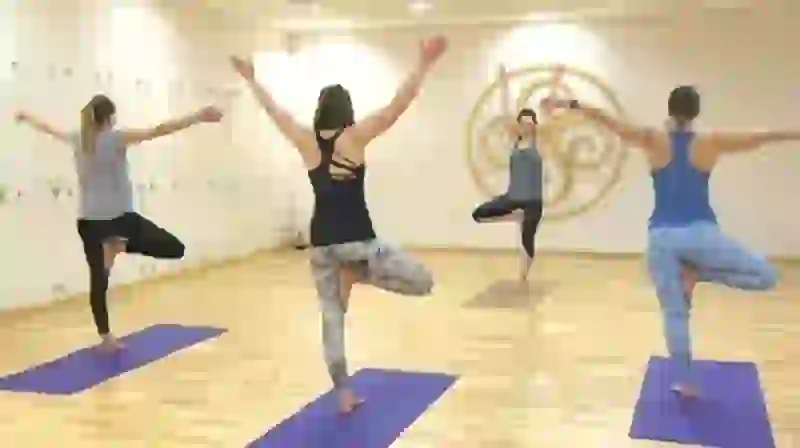
It is best to start stretching with a light warm-up. It includes a complex of scrolling movements of all joints, and may also involve walking at a brisk pace in place or shallow squats. It should be remembered that stretching for pregnant women and for pregnant women is very different. During pregnancy, all heavy and deep bends, too active squats, sudden movements are completely excluded. You also need to be careful when stretching while lying on your back. Many women are prohibited from this position during pregnancy because it puts unnecessary stress on the fetus and uterus.
Contraindications to stretching during pregnancy
There are some contraindications for stretching during pregnancy. During this period, it is better not to do stretching if the following conditions are observed:
- threat of premature birth and miscarriage;
- bad feeling;
- bad tests;
- presence of vaginal discharge;
- bleeding or threat of bleeding;
- aching and nagging pain in the lower abdomen and lower back;
- premature aging of the placenta or placenta previa;
- weak cervix;
- a history of premature birth or miscarriage;
- a history of any pathologies of the structure of the uterus and fallopian tubes.

If a woman has no contraindications, but still feels unwell, she should refrain from stretching. Since stretching in general does not have any harmful effects on the body, but involves performing various physical movements and loads, a pregnant woman should be very careful during stretching.
Restrictions
During pregnancy, swelling in the lower extremities and joint stiffness are often felt. Therefore, stretching will help get rid of many negative symptoms and manifestations during this wonderful period.
The first thing to eliminate is pressure on the stomach and prone positions. Such exercises should be skipped without exception. This is especially true for movements when the hips and knees are pressed towards the stomach.
You should also avoid twisting movements and exercises that involve the abdominal muscles. It is best to keep the spine straight, or allow a slight natural bend. Tilts can be performed gently, without jerking. But the characteristics of a pregnant woman’s body should be taken into account, so it is also better to avoid tilting the body down towards the legs.
Pregnant women should not perform exercises such as bridges and reverse bridges. There are also stretching exercises, during which a woman can feel the excessive tone of the uterus. You should immediately stop exercising and completely relax.
Jumping and swinging are prohibited in any event. Exercise for a pregnant woman should be done very gently, without stress or weight.
If shortness of breath, increased heart rate or dizziness suddenly appears, you need to lie down and relax. There is no point in continuing the activity.
Recommendations for preparation
Stretching during pregnancy is aimed not only at strengthening ligaments and improving muscle elasticity. It can also strengthen blood vessels and improve heart function.
It is worth paying attention to the body weight of the pregnant woman. Excess weight will put additional stress. Such women should be very careful because they are at risk when stretching. It may be an excessive burden for them.
If a woman has not previously engaged in any physical exercise, and during pregnancy suddenly decides to start, then she should consult a doctor and do better with a professional trainer. If a pregnant woman has previously led an active lifestyle and stretching is not new to her, then she can exercise independently at home.
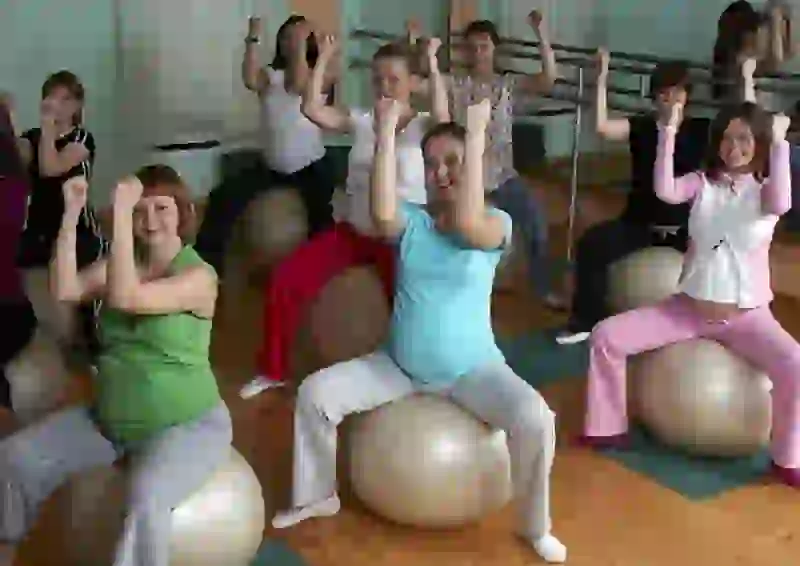
The load on the heart increases during stretching, so it is important to prepare your body before stretching. Light rolling movements of the joints, walking in place at a brisk pace and light shallow squats are suitable for this. This warm-up set will be good preparation before stretching.
Basic rules for doing exercises at home
In the first trimester of pregnancy, you need to be especially careful, since the fetus is actively developing at this time and you can easily harm its development and growth. All movements should be smooth and soft, without bending, bending or twisting.
If a pregnant woman is going to start practicing at home on her own, she should first study the technique of performing the complex in order to eliminate the risk of injury.
During pregnancy, the body is relaxed, all joints and ligaments are preparing for subsequent childbirth, so they are more elastic and much more difficult to injure. But you shouldn't strain yourself too much.
You can study a couple of times a week for no more than one hour. You should drink plenty of water during class. Conduct the lesson in a ventilated room. Clothing should be comfortable and not restrict movement.
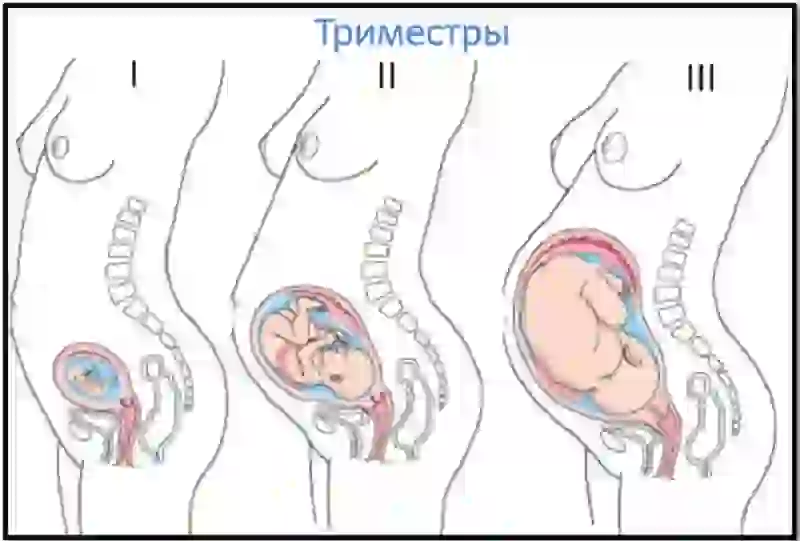
Cloth
Special overalls, which can be purchased at sportswear stores or yoga supply stores, are best suited for classes. It will also be convenient to exercise in loose leggings, leggings, and breeches made of cotton natural breathable fabrics. You can wear a T-shirt or tank top on top.
The main thing is that your clothes are easy and comfortable to exercise in, so that they do not interfere with stretching.
A set of exercises for stretching muscles during pregnancy
It is best to start the lesson with a light warm-up of the muscles and ligaments, which will be followed by a session first on the upper part of the body, then on the lower part.
It is better to avoid splits during pregnancy, but if a woman has done the splits before, then it is quite possible to continue doing this exercise.
For 1st trimester
It is better to completely exclude sports exercises during pregnancy if we are talking about the first 12 weeks. In the early stages, many women are at risk of miscarriage, so you should be very attentive to your health during this period.
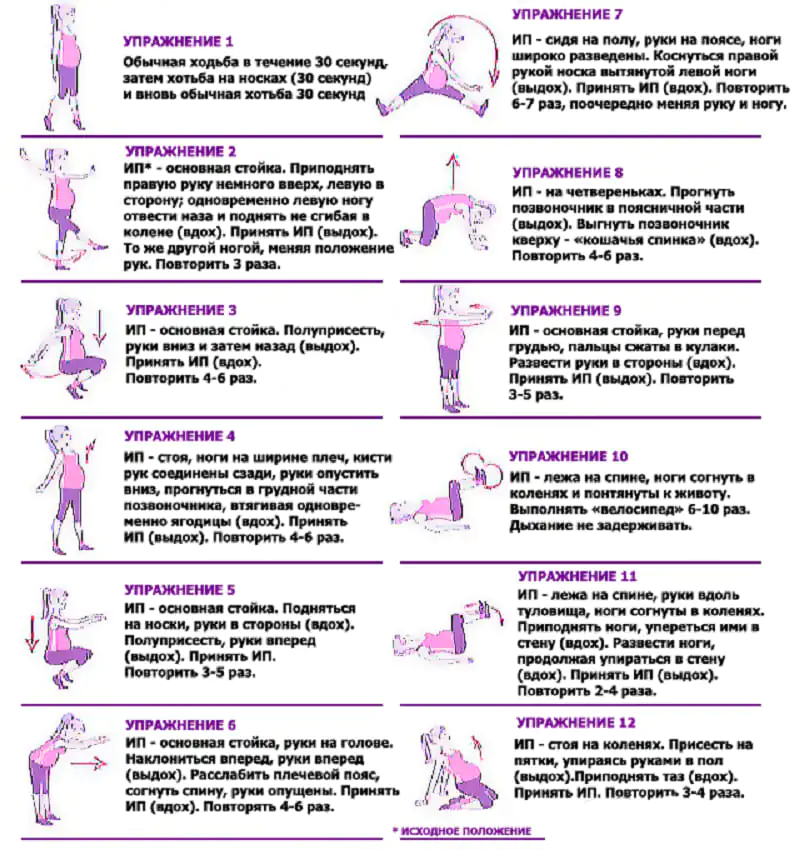
In the first trimester, the body undergoes dramatic hormonal changes, which entails mood changes, changes in blood pressure, weight changes and deterioration in well-being. It is very important to stretch very carefully in the first weeks of pregnancy. It is best to conduct classes for the upper limbs and spine, completely eliminating the load on the hips and lower back.
For 2nd trimester
Stretching exercises during pregnancy in the second trimester should be soft and gentle. It is best to exercise in the morning, when the pregnant woman is still active and feels well.
The best complexes would be exercises on special balls, exercises for stretching the spine and lower back in particular.
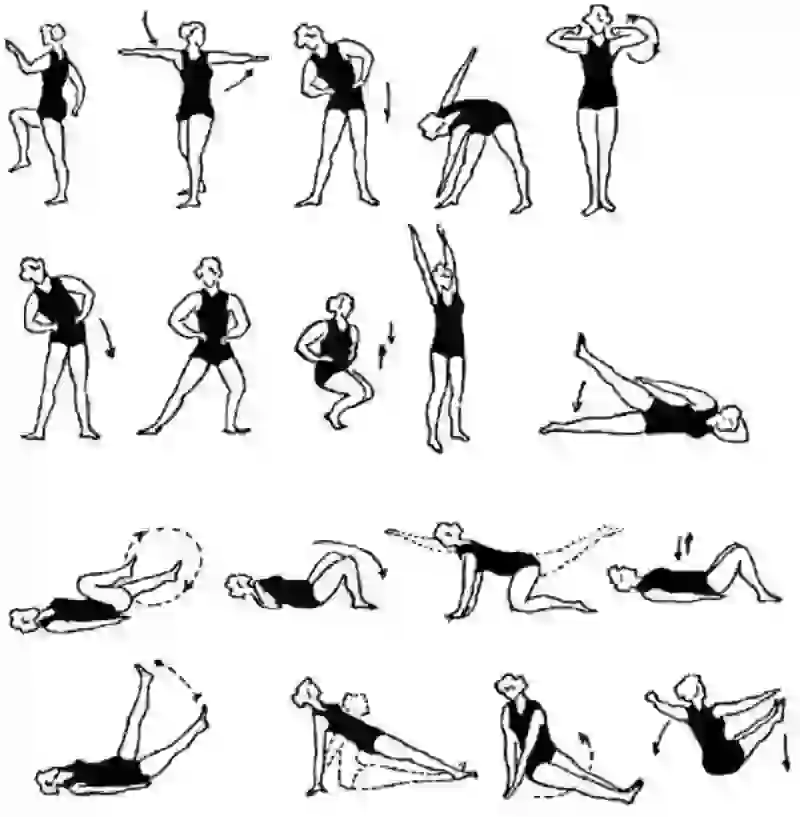
Loads on the abdomen and twisting should be avoided.
For 3rd trimester
Gymnastics during pregnancy and stretching may include a set of Kegel exercises, if we are not talking about the first trimester of pregnancy. In the third trimester, it will be good for a woman to strengthen the muscles of the perineum to reduce the risk of ruptures during childbirth and improve the passage of the baby through the birth canal.
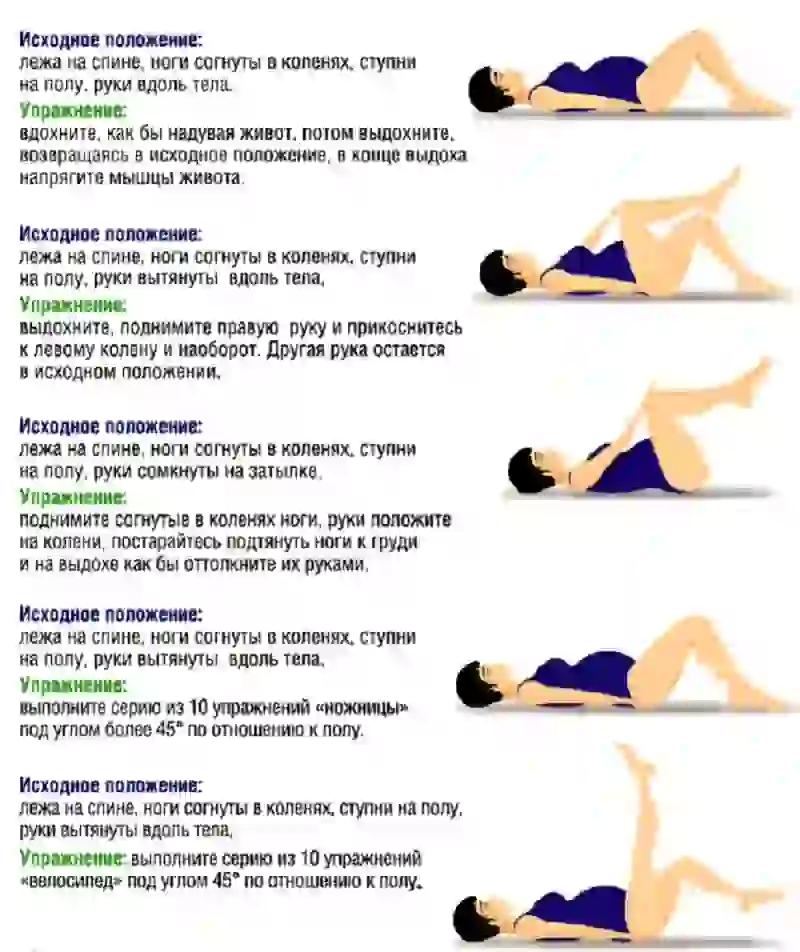
Prepared women recover faster after childbirth. Stretching is beneficial at any stage of pregnancy. In the third trimester, if a woman has no contraindications, she can follow the same program as in earlier stages. You can also add exercises while lying on the floor, but exclude the position of lying on your back.



